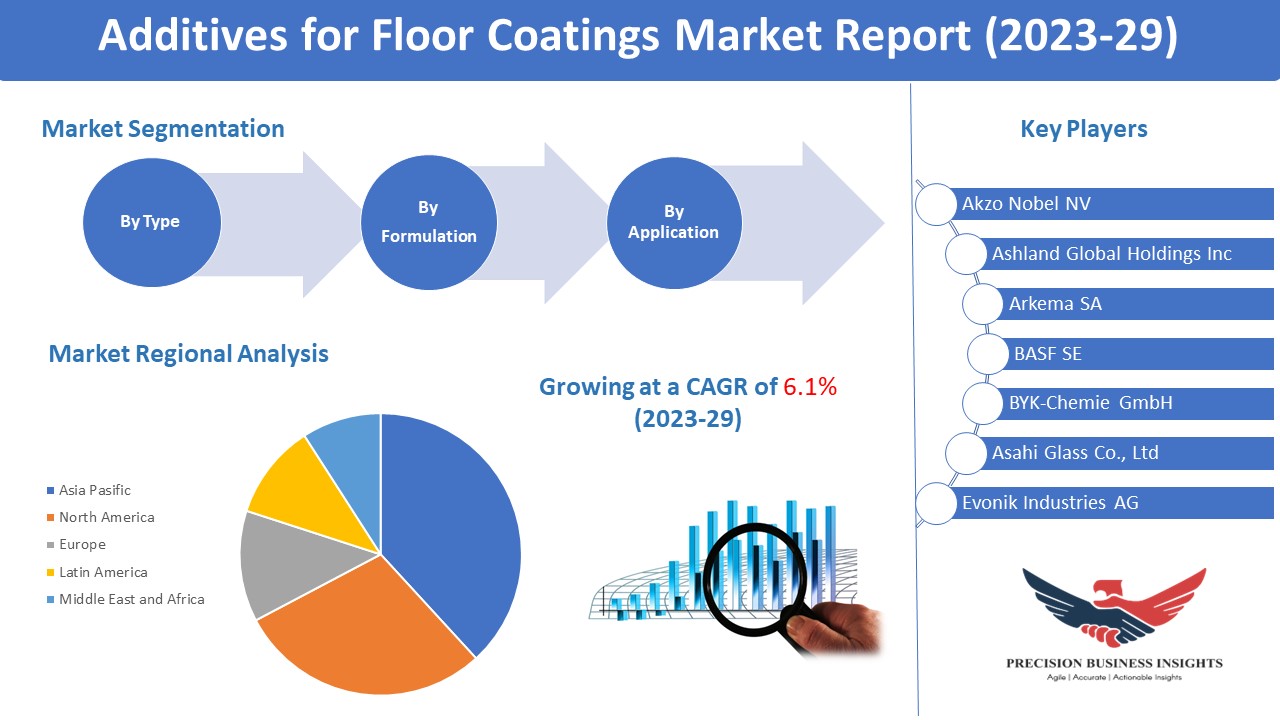Additives for Floor Coatings Market 2023: Key Industry Growth Insights
Additives for Floor Coatings Market Growth is attributed to the Increased Demand for High-Performance Floor Coatings in Construction Industry
Additives for Floor Coatings Market Overview:
According to Precision Business Insights (PBI), the latest report additives for floor coatings market size was valued at USD 10,753.1 million in 2022, growing at a 6.1% CAGR from 2023 to 2029. The increasing demand for floor coatings that adhere to green construction guidelines and have eco-friendly ingredients owing to the adoption of stringent environmental regulations to achieve properties such as fire resistance, chemical resistance, and durability drives the additives for the floor coatings market. Furthermore, the rising remodeling and renovation projects in both the residential and commercial sectors to enhance the performance of current floor surfaces are anticipated to propel the market demand.

The additional need to manufacture specific floorings in manufacturing and maintenance facilities of automotive and aerospace industries contributes significantly to the surge in market demand. Furthermore, smart coating developments, such as those that incorporate sensors or responsive elements, offer several opportunities for additive development to improve the technological capabilities of floor coatings leading to a further surge in market demand. Currently, the growing trend of UV-cured coatings, that offer a quick cure time and minimal environmental impact, has an impact on the creation of UV-compatible additives in the market. Moreover, the growing demand for additives in several end-user industries, the development of new grades of the material with improved properties, continued advancements in technology, increasing industrialization and urbanization globally, and the adoption of several government investment and initiatives in the construction industry is anticipated to heighten the market demand over the forecast years.
The Additives for floor coatings market is segmented based on type, formulation type, application, and geography.
Based On The Type:
- Anti-Foaming Additives
- Wetting & Dispersion Additives
- Biocidal Additives
- Rheology Modification Additives
- Impact Modification Additives
- Others
Based On The Formulation Type:
- Solvent-Based
- Water-Based
Based On The Application:
- Industrial Use
- Commercial Use
- Residential Use
Rheology Modification Additives Dominate the Additives for Floor Coatings Market:
Based on the type, the rheology modification additives are anticipated to show a significant growth rate in the market share over the forecasting period. Rheology modification additives influence the viscosity and flow properties of floor coating formulations. Thus, during application, these additives aid in achieving the appropriate consistency and workability, resulting in a smooth and even coating. Additionally, the ease of implementation in comparison to other options fuels market demand. In addition, it avoids problems like sagging or leaking, which is vital for vertical surfaces or complex geometries where maintaining an equal coating thickness is crucial. Additionally, the rheology modification additives are used in many other floor coating compositions, such as epoxy, polyurethane, acrylic, and others. The market for floor coatings as a whole benefit from their adaptability. Rheology modification additives are frequently essential for specialty coatings to achieve the appropriate aesthetic and functional results, such as those made for decorative or high-performance applications.
Based On Geography:
- North America
- Europe
- Asia Pacific
- Latin America
- MEA
Asia Pacific Leads the Additives for Floor Coatings Market
Additives for the floor coatings market have been segmented into North America, Europe, Asia Pacific, Latin America, and the Middle East and Africa. Asia Pacific accounted for a significant share of the additives for the floor coatings market. The market is expected to grow at a significant CAGR over the forecast years owing to the booming industrial and manufacturing sectors in Asia Pacific. Furthermore, the demand is being facilitated by the expanding construction projects in a variety of industries, including residential, commercial, industrial, and power & utility construction. A significant user of coatings, including floor coatings in industrial facilities, is the automotive sector. There is a sizable need for additives in this context because Asia Pacific is a center for the manufacturing of automobiles. North America is also anticipated to grow owing to the significant research and development activities, technology advancements along with the increased investment for industrial and manufacturing sector development.
Strategic New Product Launches, Mergers, Acquisitions, and Agreements are the key strategies adopted by market players
Additives for floor coatings market further reveals that the key players increasingly adopting strategies such as the launch of newer products, product launches, and long-term alliances to improve market revenue share and gain significant geographic presence across the region. For instance,
- In January 2023, Saint-Gobain acquired Matchem and IDP Chemicals in Brazil and Egypt to strengthen its position in construction chemicals, in particular concrete admixtures that play a key role in the decarbonization of the construction industry. It is particularly employed in tile fixings, wall and floor coatings, and waterproofing membranes.
- In June 2022, Euclid Chemical acquired Chryso’s North American cement grinding aids and additives business to enhance the performance of cement and to reduce CO? emissions during its production.
The additives for floor coatings market key players are Akzo Nobel NV, Arkema SA., Ashland Global Holdings Inc., BASF SE, BYK-Chemie GmbH, Asahi Glass Co., Ltd., Dow Chemical, Evonik Industries AG, Solvay SA, Momentive Performance Materials, Inc., Arch Chemicals, and Lonza Group AG.